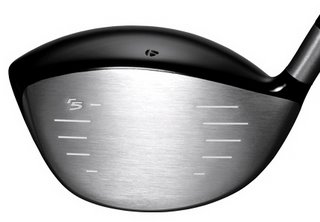 Just look at the new TaylorMade drivers. They don't even have grooves in the contact area." Everyone just looked at me dumbfounded.
Just look at the new TaylorMade drivers. They don't even have grooves in the contact area." Everyone just looked at me dumbfounded.According to equipment guru Frank Thomas, "...the grooves on a driver do nothing with regard to ball spin." In fact, some studies have shown that grooves on a driver can actually decrease spin. Pat Ryan Golf wrote about the findings of Art Chou of Chou Golf Design Labs and Deshou Liang of Drexel University. They discovered that a smooth faced club at low loft angles (less than 20 degrees) produces more backspin than a rough surface.
So grooves on drivers don't add spin. But how about other clubs? Surely, grooves make a difference, right? Yes, just not in the way that most people think.
According to Paul Smith:
The backspin is created by the balls compression on the clubface. This occurs between the time of impact and the moment of separation from the clubface. The clubs swing path and type of head rotation sees the ball mashed into the clubface. The loft presented to the ball distorts it in shape and gives us the launch angle and all of its backspin. The ball does not actually ever ride up the clubface, instead it gets imbedded in the face where the groove lines reside. High-speed photography has proved this. The more loft the greater the backspin.
Therefore, the grooves have zero influence on the launch angle or backspin on the ball. Well known club designer Ralph Maltby built a set of irons with no face groves at all and played with them extensively to prove this point to disbelievers.
Also, in the mid 1980's the USGA undertook extensive groove type testing and concluded that in dry conditions it was loft, not grooves that put backspin on the ball.
So what good are grooves then? Rather like car tyres which work perfectly in the dry, we need them to work in the wet as well. Clubfaces without grooves work fine in dry conditions but with water and grass in the way, the grooves allow some of the trapped materials to be moved from the collision zone. Without groves you may get a high flyer with less spin and in this instance the ball does in fact run up the face - it actually skids up the face on the lubricating water and/or grass.
The Sand Trap offers a similar explanation saying, "The main purpose of grooves is to collect dirt, grass, and water, thus increasing ball/steel contact." So if grooves aren't the primary producers of spin, then how do those pros on TV hit those high-spinning shots? Frank Thomas explains, "pros produce high spinning shots by striking the ball cleanly with a descending blow on an oblique angle..." In other words, perfect ball-striking.
Tidak ada komentar:
Posting Komentar